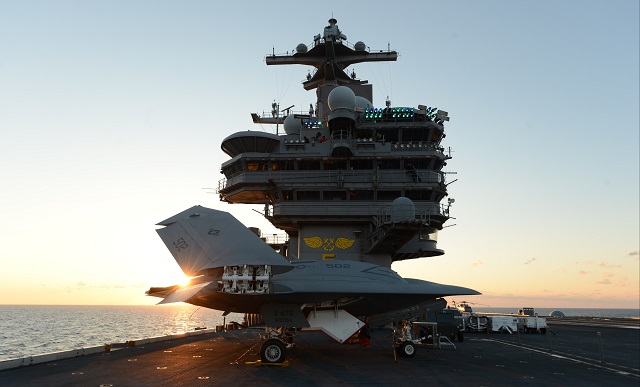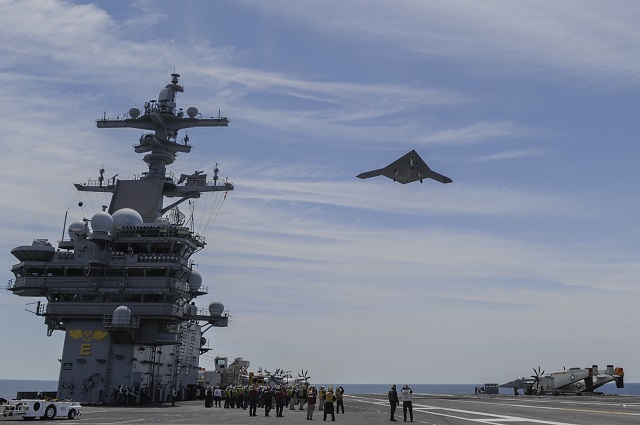| |
|||
| a | |||
Focus - Naval Technology |
|||
| X-47B UCAS-D First Catapult Launch from USS George H.W. Bush (CVN-77) a Success | |||
The X-47B
Unmanned Combat Air System demonstrator (UCAS-D) completed its
first ever carrier-based catapult launch from USS George H.W. Bush (CVN
77) off the coast of Virginia today. "Today we saw a small, but
significant pixel in the future picture of our Navy as we begin integration
of unmanned systems into arguably the most complex warfighting environment
that exists today: the flight deck of a nuclear-powered aircraft carrier,"
said Vice Adm. David Buss, commander, Naval Air Forces, the Navy's "Air
Boss". |
|||
 ATLANTIC OCEAN (May 14, 2013) An X-47B Unmanned Combat Air System (UCAS) demonstrator launches from the aircraft carrier USS George H.W. Bush (CVN 77). George H.W. Bush is the first aircraft carrier to successfully catapult launch an unmanned aircraft from its flight deck. (U.S. Navy photo courtesy of Northrop Grumman by Alan Radecki/Released) |
|||
The unmanned aircraft launched from the deck of George
H.W. Bush at 11:18 a.m. It executed several planned low approaches to
the carrier and safely transited across the Chesapeake Bay to land at
Naval Air Station Patuxent River, Md., after a 65-minute flight.
Buss called the launch a "watershed event" in naval aviation and said he expects that decades from now, a future "Air Boss" will have a picture of the X-47B launching from Bush behind his or her desk just as he has a picture of aviation pioneer Eugene Ely's first-ever landing on the deck of a ship in 1911 behind his desk today. |
|||
|
|
|||
Sagem already develops and produces the Hammer AASM
(Armement Air-Sol Modulaire) modular guided weapon for this market.
Working with prime contractor MBDA, Sagem also makes the sights and
seeker for the Mistral air defense missile, and the seeker for the infrared
version of the Mica air-to-air/surface-to-air missile. In addition,
Sagem was selected to develop and produce the infrared seeker for the
MMP medium-range missile and MBDA's air-to-surface and light antiship
missiles*.
Sagem understands and applies all technologies needed for the development and production of inertial sensors for navigation and stabilization systems, including gyros (laser,fiber-optic and vibrating), accelerometers (pendulous and vibrating) and MEMS (Micro Electro Mechanical Systems) * FASGW(H) / ANL: Future Anti-Surface Guided Weapon – Heavy / Anti- Navire Léger. |
 ATLANTIC OCEAN (May 14, 2013) An X-47B Unmanned Combat Air System (UCAS) demonstrator is lifted on an aircraft elevator aboard the aircraft carrier USS George H.W. Bush (CVN 77). George H.W. Bush is scheduled to be the first aircraft carrier to catapult launch an unmanned aircraft from its flight deck. (U.S. Navy photo by Mass Communication Specialist 2nd Class Tony D. Curtis/Released) |
|||
Completing another important first for the UCAS-D program,
the team demonstrated the ability to precisely navigate the X-47B within
the controlled airspace around an aircraft carrier at sea and seamlessly
pass control of the air vehicle from a "mission operator" aboard
the carrier to one located in the Mission Test Control Center at NAS Patuxent
River for landing.
"The flight today demonstrated that the X-47B is capable of operation from a carrier, hand-off from one mission control station to another, flight through the national airspace, and recovery at another location without degradation in safety or precision," said Matt Funk, lead test engineer for the Navy UCAS program. |
|||
 ATLANTIC OCEAN (May 14, 2013) An X-47B Unmanned Combat Air System (UCAS) demonstrator flies over the aircraft carrier USS George H.W. Bush (CVN 77). George H.W. Bush is the first aircraft carrier to successfully catapult launch an unmanned aircraft from its flight deck. (U.S. Navy photo courtesy of Northrop Grumman by Alan Radecki/Released) |
|||
Prior to the catapult launch on Tuesday, the UCAS test
team also conducted deck-handling and ship-integration testing to demonstrate
the capability to safely operate the X-47B in the dynamic, unforgiving
environment of an aircraft carrier flight deck.
"This event is a testament to the teamwork, professionalism and expertise of everyone involved with X-47B program," said Rear Adm. Mat Winter, program executive officer for Unmanned Aviation and Strike Weapons. "Their work will positively impact future unmanned aviation development for years to come." Over the next few weeks, the X-47B aircraft will fly approaches to the ship multiple times and eventually land on the pitching flight deck, said Navy UCAS Program Manager Capt. Jaime Engdahl. The UCAS team will conduct additional shore-based testing with the X-47B at NAS Patuxent River in the coming months before its final carrier-based arrested landing demonstration later this summer. From Naval Air Systems Command Public Affairs Link to X-47B Technical Datasheet |
|||










